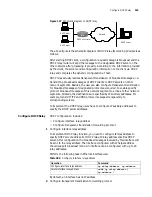
352
C
HAPTER
21: C
ONFIGURING
IP A
PPLICATION
access control list, then locate the corresponding data pool according to the
correlation. Thus, the source address is translated into one address in the data
pool and the address translation process is completed. In the translation
correlation form, the necessary corresponding information of the translation,
including access list, data pool information and the HASH table index
corresponding to the address pool are recorded.
HASH table is correlated to the data pool. That is to say, “the data packet that
implements address translation using the addresses in the address pool” will have
the record recorded in HASH table. During the translation, we can find the data
pool that corresponds with the data packet according to the translation
relationship. According to the address pool, we can find HASH and records the
translation record in the corresponding HASH table. In the restoration process, the
address pool can be located according to the destination address. And according
to the address pool, the relevant HASH table can be located, to implement
restoration operation.
Please carry out the following configuration under interface view.
Table 384
Configure the correlation between the access control list and address pool
By default, the access control list is not correlated to any address pools.
3
Configure the incidence between the access control list and the interface (EASY IP
feature)
Configure the correlation between the access control and the interface is also
known as EASY IP feature. It refers to taking the IP address of the interface as the
translated source address directly during the course of address translation, which
is applicable to two conditions. In dial view, the user hopes to take the interface IP
address obtained through negotiation as the translated source address; or the user
hopes to take the IP address of the interface itself as the translated source address.
Please carry out the following configuration under interface view.
Table 385
Configure the correlation between the access control list and the interface
By default, the access control list is not correlated to any interface.
4
Configure the Internal Server
The user can map the corresponding external address, the external port number
etc. to the internal server, to implement function for the external network to visit
the internal server. The mapping table between the internal server and external
network address and port number is configured by
nat
server
command. During
the course of address restoration, the destination address of the external data
packet will be looked up according to the configuration of the user. To visit the
internal server, it is translated to the destination address and port number of the
Operation
Command
Add the correlation between the access control list
and address pool.
nat outbound
acl-number
address-group
pool-name
Delete the correlation between the access control
list and address pool.
undo nat outbound
acl-number
address-group
pool-name
Operation
Command
Add the correlation between the access control list and
interface.
nat outbound
acl-number
interface
Delete the correlation between the access control list
and interface.
undo nat outbound
acl-number
interface
Summary of Contents for 3036
Page 1: ...http www 3com com 3Com Router Configuration Guide Published March 2004 Part No 10014299 ...
Page 4: ...VPN 615 RELIABILITY 665 QOS 681 DIAL UP 721 ...
Page 6: ...2 ABOUT THIS GUIDE ...
Page 7: ...I GETTING STARTED Chapter 1 3Com Router Introduction Chapter 2 3Com Router User Interface ...
Page 8: ...4 ...
Page 16: ...12 CHAPTER 1 3COM ROUTER INTRODUCTION ...
Page 34: ...30 ...
Page 60: ...56 CHAPTER 3 SYSTEM MANAGEMENT ...
Page 98: ...94 CHAPTER 6 DISPLAY AND DEBUGGING TOOLS ...
Page 110: ...106 ...
Page 114: ...110 CHAPTER 8 INTERFACE CONFIGURATION OVERVIEW ...
Page 158: ...154 CHAPTER 10 CONFIGURING WAN INTERFACE ...
Page 168: ...164 ...
Page 188: ...184 CHAPTER 13 CONFIGURING PPPOE CLIENT ...
Page 192: ...188 CHAPTER 14 CONFIGURING SLIP Router ip route static 0 0 0 0 0 0 0 0 10 110 0 1 ...
Page 248: ...244 CHAPTER 16 CONFIGURING LAPB AND X 25 ...
Page 320: ...316 ...
Page 330: ...326 CHAPTER 20 CONFIGURING IP ADDRESS ...
Page 362: ...358 CHAPTER 21 CONFIGURING IP APPLICATION ...
Page 374: ...370 CHAPTER 23 CONFIGURING IP COUNT ...
Page 406: ...402 CHAPTER 25 CONFIGURING DLSW ...
Page 408: ...404 ...
Page 452: ...448 CHAPTER 29 CONFIGURING OSPF ...
Page 482: ...478 CHAPTER 30 CONFIGURING BGP ...
Page 494: ...490 CHAPTER 31 CONFIGURING IP ROUTING POLICY ...
Page 502: ...498 ...
Page 508: ...504 CHAPTER 33 IP MULTICAST ...
Page 514: ...510 CHAPTER 34 CONFIGURING IGMP ...
Page 526: ...522 CHAPTER 36 CONFIGURING PIM SM ...
Page 528: ...524 ...
Page 532: ...528 CHAPTER 37 CONFIGURING TERMINAL ACCESS SECURITY ...
Page 550: ...546 CHAPTER 38 CONFIGURING AAA AND RADIUS PROTOCOL ...
Page 590: ...586 CHAPTER 40 CONFIGURING IPSEC ...
Page 599: ...IX VPN Chapter 42 Configuring VPN Chapter 43 Configuring L2TP Chapter 44 Configuring GRE ...
Page 600: ...596 ...
Page 638: ...634 CHAPTER 43 CONFIGURING L2TP ...
Page 649: ...X RELIABILITY Chapter 45 Configuring a Standby Center Chapter 46 Configuring VRRP ...
Page 650: ...646 ...
Page 666: ...662 ...
Page 670: ...666 CHAPTER 47 QOS OVERVIEW ...
Page 700: ...696 CHAPTER 49 CONGESTION MANAGEMENT ...
Page 706: ...702 CHAPTER 50 CONGESTION AVOIDANCE ...
Page 707: ...XII DIAL UP Chapter 51 Configuring DCC Chapter 52 Configuring Modem ...
Page 708: ...704 ...
Page 762: ...758 CHAPTER 52 CONFIGURING MODEM ...
















































